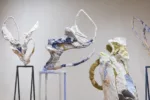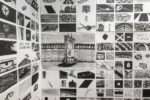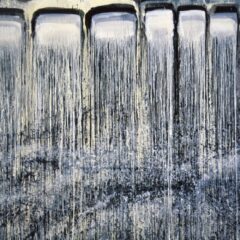Societal breakdown is in the air at this season’s Wind Challenge 2 at Fleisher Art Memorial. The three artists–Erin Riley, Anita Allyn and Laura Ledbetter–take very different approaches in the newest iteration of this revered series of juried art shows, dating back to 1978.
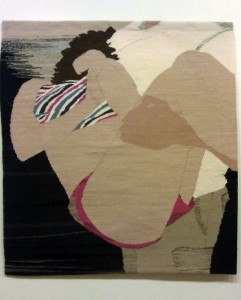
Erin Riley’s 10 hand-woven, hand-dyed tapestries are the most personal, even though some of her imagery comes from Internet searches. An aura of threat pervades these excellent weavings, images of not-quite-pinned-down narratives that trouble and disturb. The weaving itself abstracts the images somewhat, giving the ideas in them room to breathe. And the labor-intensive process gives heft to otherwise ephemeral moments that might otherwise pass unnoticed.
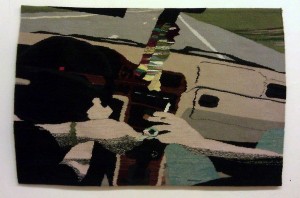
In Passing Lane, an image of two people in a car, is it a key being passed–or a church key–and is there alcohol involved or speed or speeding? Either way, the ominous narrative suggests a perfectly ordinary moment frozen in time to explain an impending disaster–a crash or even a hit and run.
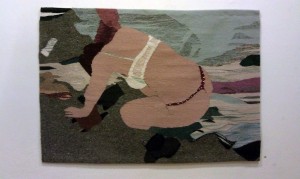
In the equally seemingly ordinary moments captured in Undressing and Passed Out, something larger lurks–a social climate of drunkenness and vulnerability. The images capture this moment in time, with its pervasive self-exposure and public sexuality. This can’t be good. At the same time these images evoke Lautrec or Degas images of women deshabille at their toilet. But something critical has changed–the reflective, static mood of those older works has been replaced by a frantic tone. The exhibitionism is fraught as no-longer private lives spin out of control.
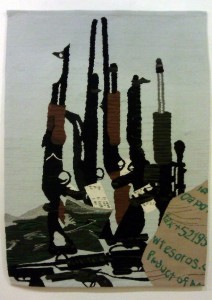
Loot 4 suggests a carelessness, a courting of danger–the indiscreet lives of a the economically disadvantaged heading straight for a fall as they try to get a toe hold for economic survival.
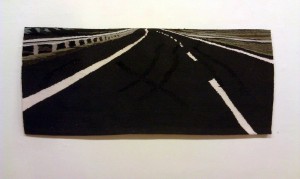
This work, all made in 2011, shows an artist risking a move away from the subject matter that has earned her great success–images of vehicles and crashes. The risk she took has paid off. The quantity of work, in such a labor-intensive medium, suggests enormous focus on the artist’s part. Plus the sheer effort of hand weaving and dying gives what might be fairly neutral or painfully common scenes a gravitas and provides fair warning to the 1% that they better start sharing or worse is yet to come.
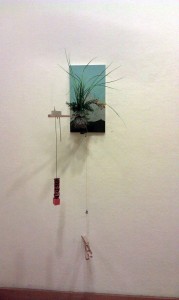
Laura Ledbetter’s eight unstable scenarios with Rube Goldberg-like cause-and-effect pulleys and levers are either drawings, some with collage or sewing, or wall-mounted assemblage sculptures.
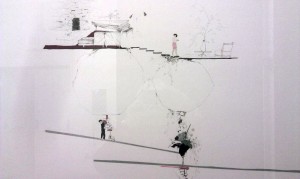
The delicate drawings with thick, collaged-on bits of color mash together global boulders and private lives. A lever activated by an endangered but cozy dwelling could flip a giraffe in the bush. Sewn features also give the barely-there images some heft. Several small sculptures communicate similar economic, ecological and social instability, with plumbing plunging down toward some undefined cess-pool of infinity, or with weights and pulleys suggesting a cosmic mechanical system barely hanging on. The work brings to mind Sarah Sze’s fragile invasions of building systems.
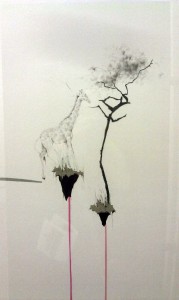
The fragility of the collage drawings at first annoyed me with their anti-graphic aesceticism, but then they drew me in with their complex spatial relationships that move around the pictorial surface to create a narrative of time-based events. The tactility of the collage pin down to the real world drawings so pale that they practically disappear.
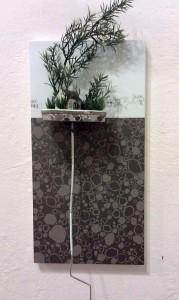
Although I preferred the quick accessibility of ideas in the sculptures–the clear expression of a fragile existence endangered by toxic emissions of smoke and effluent into not just the local pond but into the whole universe–the drawings have their own contrarian impact. They remind me of teachers who use hushed tones to quiet boisterous classes. The barely visible lines pulled me in, slowed me down, and suddenly I had spent five minutes examining the global danger suggested by each of the delicate trip wires to disaster that Ledbetter depicts. This artist showed in the spring at Pentimenti and I hope to see more of her work.
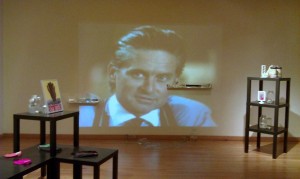
The third show, by Anita Allyn, is an installation of familiar current-event and media images, along with ordinary objects arrayed like merchandise on display shelves. The shopping milieu is successful in holding the space and creating an overwhelming environment of commercial and media bombardment.
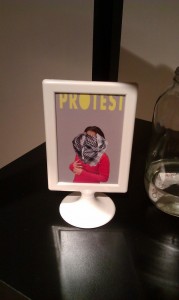
Amid the t-shirts, the floating Chinese money, the symbols of revolt and crass commercialism, the most powerful thing to look at is the projected video-loop face of Gordon Gecko (i.e. Michael Douglas as the greediest film character ever–in the movie Wall Street). The installation is overtly political, yet I came away wondering just what the political point of view was. Much like Occupy, Allyn doesn’t quite succeed in transforming the powerful content of protest and greed into something coherent or transcendent–at least not so far as I can see.
The good news, or the bad, depending on how you look at at, is that the messages of the three artists add up to an indictment of a messed up world. It’s our mess. And who can argue with that?
Wind Challenge 2
Dec. 9, 2011 to Feb. 5, 2012
Fleisher Art Memorial
719 Catharine Street
215-922-3456 ext. 300
Erin Riley will be speaking there Dec. 15, 6pm



